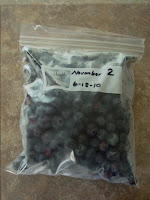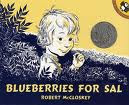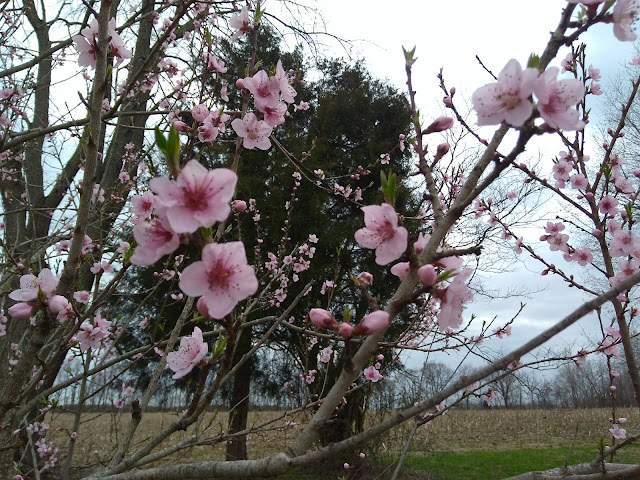Kuplink, kuplank, kuplunk.
Kuplink, kuplank, kuplunk. That's the sound Little Sal's blueberries make as they drop into her metal pail. Robert McCloskey’s delightful picture book, Blueberries for Sal, tells of the adventures of Little Sal and her mother as they pick berries on Blueberry Hill. Sal’s mother plans to can blueberries so they will have food for winter, but they meet up with a mother bear and her cub who are also storing food for winter! Charming pictures and a mix-up of mothers and offspring make for a book that every preschooler should have the pleasure of knowing. Blueberries for Sal was chosen as a Caldecott Honor Award Winner in 1949, and sixty-one years later it’s still every bit as appealing. It's been a favorite of mine since childhood, and I have loved re-reading it with each of my young children.
We’ve been putting up blueberries for winter here as well, but rather than canning, we prefer to freeze most of our berries. Whether you pick berries from your backyard, a U-Pick farm, or from a grocery store display (Michigan berries will be in season in a month or so), freezing blueberries couldn't be any simpler, and is a great project to do with your children. In fact, this is the first project kids do in 4-H Food Preservation. In case you haven’t tried it, here are the steps to “flash freeze” berries:
1. Wash berries and let drip dry. Pick out any stems, leaves, or unripe berries.
2. Spread in single lay in pans. I put paper towels underneath to soak up any water that remains on the fruit.
3. Cover with waxed paper.
4. Freeze until solid.

5. Put in freezer zip bag or other freezer container. Store well for up to 1 year.
Flash freezing, for the home food preservationist, simply means freezing an item in a single layer, then storing it in a some more space saving manner. Doing blueberries this way insures that they won't stick together, and then later you can take out exactly the amount you need.
Last year I tried something new to help me ration my berries equally throughout the year. I decided that I'd like to have two quart bags each month, so I labeled the bags "January 1", "January 2", "February 1", "February 2", and so on. I actually start with May and work backwards, so the most easily accessible bags will be "August 1" and "August 2". (During June and July we have all the fresh berries we can eat.) We may have enough berries for 3 qts/month this year - we'll see. This process turned out to be so helpful that I'm planning to label the other foods I put up in a similar manner.
And, while I'm on the subject of blueberries, here are some of our favorite ways to use them:
- Muffins and scones, of course! (Add 2 T. lemon juice and 1-3 t. lemon zest to your usual recipe for extra zing.)
- Oatmeal: Frozen or fresh, blueberries are the perfect complement to oatmeal with a touch of brown sugar
- Syrup: Combine 1 c. berries, 1/2 c. water, and 1/4 c. sugar. Boil. Crush berries with back of spoon. Boil for 2-3 minutes more. Serve hot over (blueberry) pancakes, waffles, or ice cream.
- Smoothies: Try blending 1-2 bananas, 1-2 c. blueberries and/or other berries, 1 c. milk, 1 c. flavored yogurt.
- Yogurt/granola/ berry parfait: Fantastic summer breakfast!
Blueberries are high in anti-oxidants and have anti-inflammatory properties, earning them the "superfood" label by some. Others think that term is a lot of hype, but whether or not you buy that description, blueberries (and other berries) certainly are a great addition to any diet, and picking and preserving them makes for some sweet summer fun. If at all possible, after gathering berries with your children, take some time to enjoy Little Sal and her mother's experiences, too!







Comments